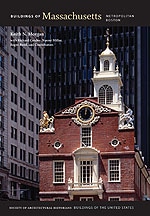
Charles Freeland, a developer of several Back Bay town houses, wishing to have a facade for his own house that more boldly stood out from its neighbors, selected the new firm of Ware and Van Brunt for his narrow two-bay house. A single stubby Ionic column in the center of the first-floor facade supports two tiers of bay windows surmounted by two tiers of projecting wall dormers at the fourth-floor and mansard roof levels. Architectural historians have noted the similarity of this inventive composition to the work of Philadelphia's Frank Furness, with whom Henry Van Brunt studied in Richard Morris Hunt's New York atelier. The design for the Charles W. Freeland House was a rare early instance of an American architectural design published in a European architectural periodical, Cesar Daly's 1870 Revue générale d'architecture, earlier issues of which may have provided the NéoGrec inspiration found here.

